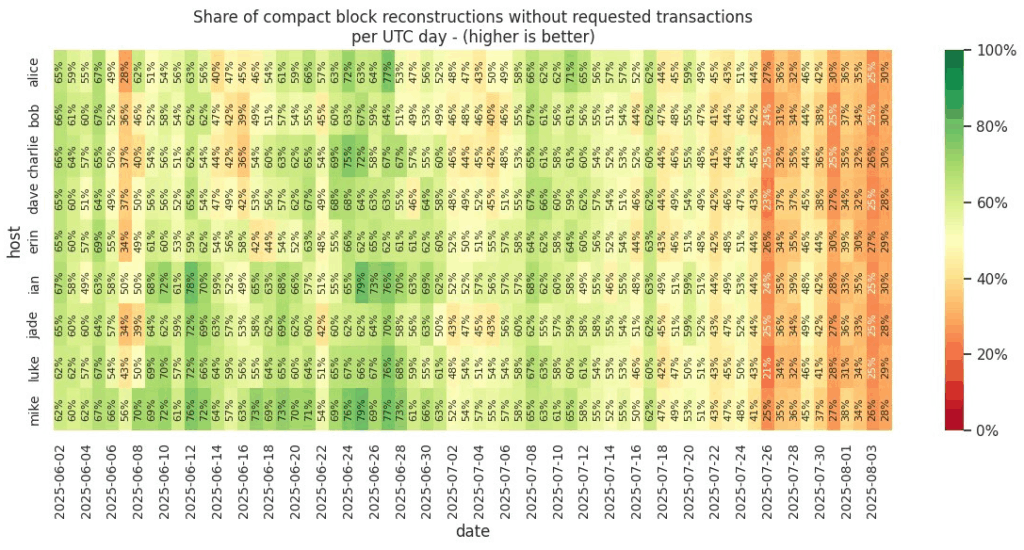Miners add cheap transactions, forcing nodes to download more data.
Compact block system fails when climbing overt 0.8 MB per block, according to POINSOT.
Antoine Poinsot, developer and collaborator of Bitcoin Core, published on August 5 in X a criticism of a growing trend between Bitcoin miners: «Congratulations ‘Summer -1Sat/VB’, you managed to ruin compact blocks».
His comment It points to a recent change in the behavior of miners, who in recent weeks They have included transactions with rates less than 1 Satoshi by virtual byte (SAT/VB), a unit that measures the cost that users pay to process their transactions in the Bitcoin network.
This phenomenon, known in social networks as the “Sub-1Sat/VB Summer”, has challenged the policies of Relay (Retransmion) Of the nodes and, according to Poinstot, he exposes vulnerabilities in the protocol of Compact blocksan optimization introduced in 2016 through the proposal to improve Bitcoin 152 (BIP-152).


What are Bitcoin’s compact blocks and how would they be harmed?
Compact blocks are a mechanism designed for accelerate the spread of new blocks in Bitcoin.
Before BIP-152, the nodes transmitted complete blocks, which consumed bandwidth and time.
Compact blocks solve this by sending a summary with transaction hashes, assuming that the nodes already have many of them in their Mempool (space where outstanding transactions are stored). If data is missing, The nodes request what is necessarythus reducing network traffic.
However, this system depends on the Mempools of the nodes are similar. The current conduct of the miners, which include sub-1 SAT/VB transactions, breaks this premise.
Traditionally, the Miners prioritize transactions with high rate for profitability. Now, before a high demand for space, some miners fill blocks with cheap transactions, possibly due to external economic agreements or maximization strategies.
Since many nodes reject these transactions by policies of Relay (as a minimum of 1 sat/vb), they don’t have them in their Mempool, Forcing additional requests and affecting the efficiency of the system.
The damage indicated by Poinsot
Poinsot warns that this “Sub-1Sat/VB” has “ruined” the compact blocks. Damage lies in a Increased latency and use of resources. Normally, a compact block requires less than 0.2 MB of additional data for reconstruction.
Currently, in accordance with the provisions of the Bitcoiner collaborator, the nodes must download up to 0.8 mb per blockeliminating the advantage of propagation time reduction. This Add communication rounds between nodes, counteracting the purpose of BIP-152 to minimize delays.
The following graph, provided by Antoine Poinsot, shows the average size of transactions that Bitcoin nodes must request daily to rebuild compact blocks, measured in Kilobytes (KB).


The previous image data covers from May 1 to August 6, 2025, with each cell representing one day and each row a specific node in the network. The color scale goes from green (low, ideal values) to red (high, problematic values), indicating that a lower size is preferable for efficiency.
In May and June, most cells are green, with average sizes below 100 KB, reflecting efficient operation of compact blocks.
As of July, especially in recent weeks, yellow and red tones predominate, With peaks that reach about 800 kb (0.8 MB) per day. This coincides with the “Sum summer/vb”, where the miners have included those transactions with rates less than 1 SAT/VB.
This situation cancels the planned efficiency, where Compact blocks reduced traffic to fractions of a megabyteand now equals or exceeds the traditional method of complete shipping. In other words, the network is working more than necessary, as if you had to ask for complete instructions instead of a summary.
Network impact and possible solutions
The problem mainly affects miners and nodes operators. The former see their blocks spread slower, reducing competitiveness, while the latter face greater bandwidth consumption.
For common users, who send transactions with standard rates, the direct impact is limited, but in the long term it could Generate congestion and rates in rates.
Poinsot suggests adjusting the policy of Relayas the PR #33106 Bitcoin Core, which Lower the minimum to 0.1 SAT/VBaligning nodes with mining reality. However, this measure requires consensus, and the “Sub-1Sat/VB summer” could reflect experiments or pressures due to structural changes.
The situation underlines the need to adapt the protocol to emerging economic dynamics, a continuous challenge for Bitcoin.


